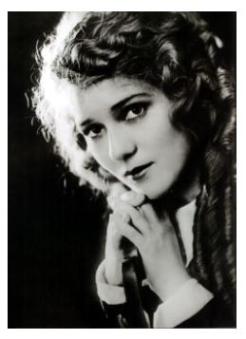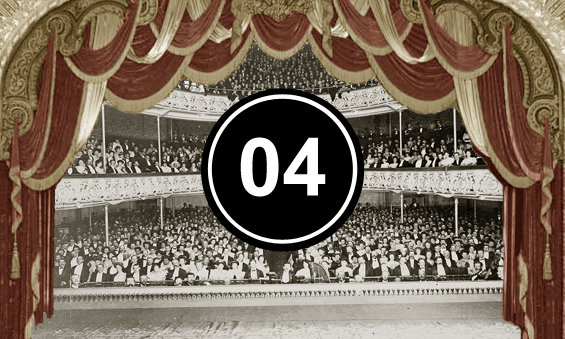In the days before University Avenue was extended south of Queen, there was a row of buildings where there's now the intersection at King Street. One of them was the Princess Theatre. Built in the late 1800s, the Princess was the first prestigious home for "legitimate" theatre in Toronto—and the only one until the Royal Alex opened down the street almost twenty years later. It brought all the biggest plays and most famous stars to the city. And in the year 1900, the Princess was showing a melodrama called The Silver King, which featured a small role for a young girl played by one Gladys Smith. It was the first time she had ever appeared on stage, but before too long, she'd be the most famous actress in the world.
She'd been born just a few years earlier and just a few blocks away, in a modest house on University, where Sick Kids is now. Her father died when she was four and her mother was talked into letting her children act as a way to bring in a little more money. She was hesitant—acting wasn't considered a respectable profession—but her daughter Gladys fell in love with it. She appeared in plays around Toronto before touring the States as a teenager and eventually landing in New York City on Broadway. It was there that a producer convinced her to change her name to Mary Pickford.
And it was there that her rise to fame really got started. She caught the attention of D.W. Griffith, a film director who would soon prove to be one of the most important men in the history of cinema. In a few years, he would make his "masterpiece", the unbelievably racist The Birth of A Nation, a silent epic about the founding of the KKK, whose members are portrayed as heroic figures battling a bunch of people in blackface. It was the highest grossing movie of all-time and such a landmark in the history of film technique that film schools still force students to sit through all three painful hours of it.
Griffith and Pickford made a powerful team. They produced 42 films together. In their first year. They helped prove that feature-length films could make money and though Pickford wasn't credited at first (no actors were back then), people were soon talking about the girl with the golden curls. As the popularity of film soared, and cinemas sprang up not only across the United States but the globe, her popularity and power soared with it. Frustrated by the studios' stranglehold on the industry, she, Griffith, Charlie Chaplin and Douglas Fairbanks teamed up to form their own distribution company for independent films: United Artists. The very next year, Pickford would divorce her abusive, alcoholic husband. She and Fairbanks were in love. They got married and became Hollywood's first celebrity couple.
By then, Pickford was already one of the most famous people in the entire world—as far as actors go, they say only Chaplin rivaled her popularity. They called her "America's Sweetheart". One overzealous reporter even declared that she was "The best known woman who has ever lived, the woman who was known to more people and loved by more people than any other woman that has been in all history." Her honeymoon in Europe with her new husband caused riots when they were spotted in London and Paris. And when they returned home to the States, taking the train back across the country to Hollywood, huge crowds gathered to watch them go by. They say that after that, when foreign heads of state came to the White House, they also asked if they could visit the Pickfair estate in Beverly Hills, where Pickford and Fairbanks were playing host to dinner guests like Albert Einstein, F. Scott Fitzgerald, H.G. Wells, George Bernard Shaw, Amelia Earhart, Noel Coward and Sir Arthur Conan Doyle.
But then came the talkies. Sound films left countless silent stars behind, as they couldn't, or wouldn't, adjust. And for Pickford, who believed that adding soundtracks to movies was "like putting lipstick on the Venus de Milo", it was a disaster. It didn't help one bit that she picked that very same time to pull a Keri Russell—cutting her beloved blonde curls in favour of a short bob. It was front page news in the New York Times. Her popularity plummeted.
In 1933, with her films making less and less money, she retired from acting. And three years after that, she and Fairbanks were divorced. (He'd had an affair with an English actress with a thing for rich and famous men—her other husbands included a baron, an earl, a Georgian prince/race car driver and Clark Gable.) Pickford kept producing movies, remarried and adopted children. But she was a cold and distant mother, became an alcoholic and died in 1979.
-----
Despite all that "America's Sweetheart" business, Pickford was still a Canadian at heart. She called herself "a real Torontonian" and fought to regain her Canadian citizenship later in life—although it turned out she'd never lost it. You can hear her talking about her memories of growing up in the city (and her love of biking downtown—take that Ford!) in a radio interview she did with the CBC in 1959, here. "At least once a month I dream I'm back again in Toronto, up in Queen's Park, High Park, up north on Yonge Street..."
You can watch clips from some of her silent films here, on the PBS website. And some of my favourite photos of her are here (with a bear cub), here (with a kitten) and here (with her short hair).
You can read more about the Princess Theatre and the fire that destroyed it in one of Jamie Bradburn's Historicist columns for Torontoist, here. Or about the theatre's rivalry with the Royal Alex, here.
If you're interested, you can watch a particularly offensive six-minute clip of The Birth of A Nation, here. And if you're really masochistic, you can watch all three hours of racist bullshit, here.
Update: Silent Toronto just published a post about the reaction in Toronto to The Birth of A Nation here. (Hint, apparently the Star's headline read: “Colored people appear to be only opponents of the film”. Ugh.
Update: Silent Toronto just published a post about the reaction in Toronto to The Birth of A Nation here. (Hint, apparently the Star's headline read: “Colored people appear to be only opponents of the film”. Ugh.
|
| This post is related to dream 04 The Silver King Mary Pickford, 1900 |










No comments:
Post a Comment
Note: Only a member of this blog may post a comment.